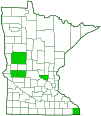narrow-leaved four o’clock
(Mirabilis linearis)
Conservation • Description • Habitat • Ecology • Use • Distribution • Taxonomy
Conservation Status |
|
|||||||
| IUCN Red List | not listed |
|||||||
| NatureServe | N5 - Secure SNA - Not applicable |
|||||||
| Minnesota | not listed |
|||||||
Description |
||
Narrow-leaved four o’clock occurs across the United States, in northern and central Mexico, and in southern Canada. It is most common in the Great Plains states. It is uncommon in Minnesota, found in just a few scattered locations. Narrow-leaved four o’clock is an erect, perennial herb that rises from a thick, dark, fleshy or woody taproot. The stems are usually hairless or nearly hairless below the inflorescence, and covered with a whitish, waxy coating. They are usually erect or curve upward from the base, occasionally they recline on the ground with the tips ascending. The leaves are opposite, untoothed, long and narrow, 1″ to 4½″ long and rarely as much as ⅜″ wide, straight, with more or less parallel sides, like a blade of grass. They narrow to a stalk-like base but are attached to the stem without a differentiated leaf stalk. They are spreading or strongly ascending at a 5° to 80° angle. The upper surface is green to blue-gray and covered with a whitish, waxy coating. They are thick, juicy, and fleshy, and become wrinkled when they age. The inflorescence is single branched clusters at the end of each stem branch and in the leaf axils. The clusters appear at the end of ⅛″ to ½″ long hairy stalks. The clusters have 3 flowers each and are themselves hairy. The flowers are ¼″ to ½″ wide. They have little or no fragrance. There are 5 pale pink to purple petal-like sepals. The sepals are fused at the base forming a tube, then flare outward. There are 5 hairy bracts, ⅛″ to ¼″ long, at the base of the flower that are fused into a pale green, sometimes tinged with purple, narrowly to widely bell-shaped cup. The flowers open in the late afternoon, giving this plant its common name, remain open all night, and close in the morning. The fruit is a one-seeded achene. It is subtended by the persistent, bell-shaped fused bracts that have increased in size as the fruit developed, becoming ⅓″ to ½″ long. |
||
Height |
||
1′ to 3½′ |
||
Flower Color |
||
Pale pink to purple |
||
Similar Species |
||
Narrow-leaved four o’clock is distinguished from other Mirabilis species in Minnesota be the narrow leaves less than ⅜″ wide. Hairy four o’clock (Mirabilis albida) has a hairy stem. The leaves are on short leaf stalks, are hairy, narrow and lance-shaped. There are no flower clusters at the end of the stems. Heart-leaved four o’clock (Mirabilis nyctaginea) has broad, egg-shaped to round lance-shaped leaves, and small flowers with much shorter tubes. |
||
Habitat |
||
Dry. Prairies, railroad tracks, disturbed areas. |
||
Ecology |
||
Flowering |
||
May to August |
||
Pests and Diseases |
||
|
||
Use |
||
|
||
Distribution |
||||
|
Sources |
|||
| 4/30/2023 | ||||
Nativity |
||||
Native |
||||
Occurrence |
||||
Uncommon |
||||
Taxonomy |
|||
| Kingdom | Plantae (Plants) | ||
| Division | Tracheophyta (Vascular Plants) | ||
| Subdivision | Spermatophytina (Seed Plants) | ||
| Class | Magnoliopsida (Dicots) | ||
| Superorder | Caryophyllanae | ||
Order |
Caryophyllales (Pinks, Cactuses, and Allies) | ||
Family |
Nyctaginaceae (four o’clock) | ||
| Tribe | Nyctagineae | ||
| Genus | Mirabilis (four o’clocks) | ||
| Subgenus | Oxybaphus | ||
Subordinate Taxa |
|||
|
|||
Synonyms |
|||
Allionia decumbens Allionia gausapoides Allionia linearis Calymenia decumbens Mirabilis decumbens Mirabilis diffusa Mirabilis gausapoides Mirabilis albida var. linearis Mirabilis lanceolata Mirabilis linearis var. subhispida Oxybaphus angustifolius Oxybaphus decumbens Oxybaphus diffusus Oxybaphus gausapoides Oxybaphus lanceolatus Oxybaphus linearis Oxybaphus linearis var. subhispidus |
|||
Common Names |
|||
linearleaf four-o’clock narrow-leaf four-o’clock narrowleaf four o’clock narrowleaf four-o’clock narrow-leaved umbrella-wort |
|||
Glossary
Achene
A dry, one-chambered, single-seeded seed capsule, formed from a single carpel, with the seed attached to the membranous outer layer (wall) only by the seed stalk; the wall, formed entirely from the wall of the superior ovary, does not split open at maturity, but relies on decay or predation to release the contents.
Axil
The upper angle where the leaf stalk meets the stem.
Bracts
Modified leaves at the base of a flower stalk or flower cluster.
Sepal
An outer floral leaf, usually green but sometimes colored, at the base of a flower.
Visitor Photos |
|||||
Share your photo of this plant. |
|||||
| This button not working for you? Simply email us at info@MinnesotaSeasons.com. Attach one or more photos and, if you like, a caption. |
|||||
|
|||||
MinnesotaSeasons.com Photos |
|||||
|
|||||

Slideshows |
||

Visitor Videos |
|||
Share your video of this plant. |
|||
| This button not working for you? Simply email us at info@MinnesotaSeasons.com. Attach a video, a YouTube link, or a cloud storage link. |
|||
Other Videos |
|||

Visitor Sightings |
|||||
Report a sighting of this plant. |
|||||
| This button not working for you? Simply email us at info@MinnesotaSeasons.com. Be sure to include a location. |
|||||
|
|||||
MinnesotaSeasons.com Sightings |
|||||

|
Created: Last Updated: © MinnesotaSeasons.com. All rights reserved. |
